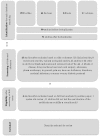Comparing the Antimicrobial In Vitro Efficacy of Amoxicillin/Metronidazole against Azithromycin-A Systematic Review
- PMID: 30347835
- PMCID: PMC6313342
- DOI: 10.3390/dj6040059
Comparing the Antimicrobial In Vitro Efficacy of Amoxicillin/Metronidazole against Azithromycin-A Systematic Review
Abstract
On account of its proven clinical efficacy, the combination of systemically administered amoxicillin and metronidazole is frequently adjuncted to non-operative periodontal therapy and well documented. Potential drawbacks of this regimen, e.g., side effects and problems with the compliance, led to an ongoing search for alternatives. Azithromycin, an antibiotic extensively used in general medicine, has recently found its niche in periodontal therapy as well. This systematic review aimed to analyze the in vitro antimicrobial efficacy of amoxicillin plus metronidazole versus azithromycin. For this purpose, a systematic literature search was performed, and studies published up to 29 March 2018 referenced in Medline, Embase, Cochrane, and Biosis were independently screened by two authors. An additional hand search was performed and studies focusing on the evaluation of in vitro antimicrobial efficacy of amoxicillin + metronidazole or azithromycin on bacteria from the subgingival biofilm were included. English and German language research reports were considered. From 71 identified articles, only three articles were eligible for inclusion. These studies showed heterogeneity in terms of analytical methods and strains explored. However, all studies used multispecies biofilm models for analysis of the antimicrobial activity. Unanimously, studies reported on more pronounced antimicrobial effects when applying the combination of amoxicillin + metronidazole, compared to azithromycin. Based on the few studies available, the combination of amoxicillin + metronidazole seemed to display higher antimicrobial efficacy in vitro than azithromycin.
Keywords: amoxicillin; antimicrobial; azithromycin; in vitro; macrolide; metronidazole; systematic review.
Conflict of interest statement
The authors declare no conflict of interest.
Similar articles
-
Systemically administered amoxicillin/ metronidazole versus azithromycin as adjuncts to subgingival instrumentation during non-surgical periodontal therapy. A systematic review.Swiss Dent J. 2020 Jul 20;130(7-8):572-583. doi: 10.61872/sdj-2020-07-08-01. Epub 2020 Jun 9. Swiss Dent J. 2020. PMID: 32515568
-
Effects of azithromycin, metronidazole, amoxicillin, and metronidazole plus amoxicillin on an in vitro polymicrobial subgingival biofilm model.Antimicrob Agents Chemother. 2015 May;59(5):2791-8. doi: 10.1128/AAC.04974-14. Epub 2015 Mar 2. Antimicrob Agents Chemother. 2015. PMID: 25733510 Free PMC article.
-
Validation of antibiotic efficacy on in vitro subgingival biofilms.J Periodontol. 2014 Feb;85(2):343-8. doi: 10.1902/jop.2013.130167. Epub 2013 May 9. J Periodontol. 2014. PMID: 23659420
-
Nonsurgical therapy of chronic periodontitis with adjunctive systemic azithromycin or amoxicillin/metronidazole.Clin Oral Investig. 2016 Sep;20(7):1765-73. doi: 10.1007/s00784-015-1683-1. Epub 2015 Dec 19. Clin Oral Investig. 2016. PMID: 26685849
-
Antibiotics against Periodontal Biofilms.Monogr Oral Sci. 2021;29:119-132. doi: 10.1159/000510188. Epub 2020 Dec 21. Monogr Oral Sci. 2021. PMID: 33427226 Review.
Cited by
-
Synthesis, Characterization, Cytotoxicity Analysis and Evaluation of Novel Heterocyclic Derivatives of Benzamidine against Periodontal Disease Triggering Bacteria.Antibiotics (Basel). 2023 Feb 2;12(2):306. doi: 10.3390/antibiotics12020306. Antibiotics (Basel). 2023. PMID: 36830219 Free PMC article.
References
Publication types
LinkOut - more resources
Full Text Sources


